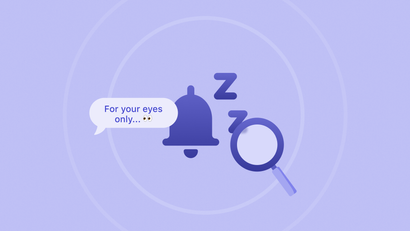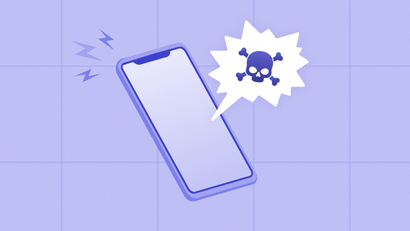User churn is a brutally candid reflection of customer satisfaction and a company’s ability to meet its audience’s expectations. If your mobile app suffers from stagnant revenue or simply can’t keep users around for more than a few weeks, it may be time to peer into that mirror and learn how to prevent user churn head-on.
Below we’ve laid the groundwork for understanding, identifying, and learning how to prevent user churn. It’s the number one reason that mobile apps struggle to grow and we’re going to show you how to proactively anticipate your users’ needs to overcome it.
What is User Churn?
User churn occurs when a customer stop using your product or service. The term “user” typically refers to app users, whereas the phrase “customer churn” is relevant to a wider variety of industries and businesses. Apps use a metric known as user churn rate to quantify the number of users they are losing in a specific timeframe, most commonly by the month.
User churn rates vary by industry, however, the consequences of a high churn rate have always been the same: crippled growth and stagnant revenue. The average app loses 77% of its daily active users (DAUs) within the first 3 days after installation.
An easy way to think of user churn rate is as the opposite of your user retention rate.
Why Does Customer Churn Matter?
It is significantly more expensive to acquire new users than it is to retain existing users. Businesses suffering from high customer churn are forced to be constantly acquiring new users, moving them through the sales funnel, and building new relationships from scratch.
Focusing marketing efforts on upselling existing customers and nurturing users who already have a rapport with your business are the paths of least resistance to revenue growth. You’re banking on existing trust, rather than trying to foster loyalty from scratch every month.
Think of how much easier it is to convince a friend or acquaintance of something over a complete stranger.
Customer Churn vs. Retention
⇢ The probability of selling to a new customer ranges from 5-20%
⇢ The probability of selling to existing customers ranges from 60-70%
How to Calculate User Churn Rate
To calculate your user churn rate, use the following formula, then multiply by 100:
Number of churned (lost) customers at the end of a time period ÷ Total number of customers at the beginning of that time period
For example, if you had 500 customers at the beginning of the month and you lost 75 customers by the end of the month, your equation would look like this:
75 ÷ 500 x 100 = 15% user churn rate
For mobile apps, customer churn may refer to both users who have uninstalled an app or users who have simply been inactive for a long period of time. Mobile apps not only need to understand how much their users are churning but also the overall value of their user base. User lifetime value assigns an average monetary value to your users so you can determine how much you should be spending to keep certain users from churning.
Read our guide for more information on calculating and improving user LTV.
How to Identify and Pinpoint Customer Churn
Every business experiences customer churn. Pinpointing where it is happening requires some purposeful digging and is a necessary first step before tackling how to prevent user churn.
- Define churn. Before you can start measuring your customer churn rate, you first need to know what it is you’re measuring. Churn differs depending on the business model. Are your churned customers canceled subscriptions, app uninstalls, or inactive users after 30 days?
- Dive into the data. Monitor retention rates at one week, one month, and 90 days. Where is user disengagement peaking? Knowing if users are hitting a skill ceiling in your gaming app and churning after week one or identifying users who become dormant after month one due to a lack of interest can help you pinpoint churn and tailor your communication strategy accordingly. Where in the user journey can you re-engage customers with mobile messaging?
- Listen to your audience. Feedback is your friend! Create customer surveys to actively reach out and get users talking about where they are experiencing the most friction with your app. Surveys can be promoted via email, in-app messaging, or a combination of the two. Not only can surveys deliver valuable insights into your user churn rate, but it shows your users you are committed to improving your app.
To learn more about identifying and reducing mobile app churn, read our dedicated guide.
What Are the Most Common Causes of User Churn?
Customers churn for all kinds of reasons — it’s not always caused by the same factors and it is not always remedied by the same factors.
Poor Onboarding Experience
The onboarding experience is where your users learn to use your app and make those crucial first snap judgments that will ultimately drive their likelihood to return. This also happens to be the area of the user journey with the most friction. New users open your app without necessarily “speaking the language” and navigate what can sometimes be a minefield of poor user experiences. Nearly every step of the onboarding process contains justifiable reasons for new users to churn and stop using your app. Common onboarding friction points include lengthy tutorials, an unintuitive user interface, or overly aggressive notifications.
Poor Customer Service
We live in an age of options and alternatives. If users feel unheard or disrespected after a poor customer service experience, you can guarantee their next stop is the uninstall button. Every app has its bugs and every business has its share of unhappy customers. Customer service isn’t about creating a mistake-free experience. It’s about how you respond when those mistakes bubble to the surface.
Poor Communication
Good communication plays a vital role in retaining customers. Too much user communication runs the risk of alienating customers with excessive notifications and overly aggressive marketing tactics. Not enough communication runs the risk of your app becoming stale, repetitive, and outright forgotten amongst the easily distracted minds of mobile users.
Other common causes of user churn may include:
- Poor UX
- Product bugs
- Poor user education
- Low perceived value/satisfaction
- Overpriced product
How to Prevent User Churn
Optimize Your Onboarding
Your goal as an emerging mobile app is to grow your MAU (monthly active users) and keep those users engaged from the first digital handshake.
86% of people say they’d be more likely to stay loyal to a business that invests in welcoming and educational onboarding content.
An effective onboarding flow should ultimately set users up for a more rewarding and seamless app experience. Use these crucial first minutes to introduce users to key features, reinforce the value of feature adoption, earn essential notification permissions, and guide them through account setup.
Use these tips to prevent user churn during the onboarding process:
- Multi-channel engagement. Just because a user exits your app during onboarding doesn’t necessarily mean they need to churn. Re-engage users on multiple channels to incentivize, entice, and remind your audience to return and finish onboarding.
- Get into the action. Having a tutorial or walkthrough for new users to complete their onboarding can be helpful but it can also be a complete drag for more tech-savvy users to sit through. Give your users a “skip” option and let them start exploring your app at their pace.
- Go beyond core features. Introducing new users to your app’s core features is valuable, but people want to know how those features will improve their lives. Adopting a benefits-driven onboarding approach drastically reduces the likelihood that users will churn before your app can deliver on their expectations.
App onboarding is an art unto itself. For more details and a few real-life examples, read our practical guide on how to build and effective mobile app onboarding process.
Offer Brag-Worthy Customer Service
Most reasonable people do not expect a perfect experience every single time they engage with a business. However, they do expect to be treated as an important customer with valid feelings. Be transparent in your communication, reassure users that you understand their criticisms, and beyond all else… be proactive.
Is your app going to be temporarily down for maintenance or an expected server outage? Send an email or SMS notification to users ahead of time to assure them you’re actively working on a solution. Always attempt to identify problems and points of friction so you can address them before an army of one-star reviews spawns in the app store.
Make sure you are publicly addressing any complaints that arise on your social media platforms. Many app users are more forgiving than people give them credit for. When you demonstrate an ability to field concerns, respond in a timely manner, and offer actionable workarounds you are proving to your users that their long-term participation on your platform will be met with long-term support.
Know and Segment Your Audience
The best way to make frequent user communication a necessity rather than a nuisance is to utilize mobile channels for carefully timed, highly personalized messaging. Push notifications, in-app messages, and SMS notifications allow businesses to segment and re-engage users based on geography, app usage, personal interests, and more to deliver hyper-relevant content directly to their lock screens.
The more targeted your audience segmentation is, the more likely your communication is to resonate with your audience and inspire action.
Reward and Incentivize
It’s not enough to get people to download your app. You must give them reasons to open your app every single day. Time-sensitive rewards are an effective way to re-engage users and incentivize them towards core features of your choosing. A daily, “streak-based” reward or well-timed discount give people both something to look forward to and scratches that satisfying itch of completing a challenge. Don’t shy away from gamifying certain aspects of your mobile app — it may just be the key to long-term retention!
Refine Your App UX
It doesn’t matter how advanced or technically sound your mobile app is if people can’t figure out how to use it. A minimalist approach to app design and menu navigation is a great way to eliminate UX churn. Likewise, mobile content and user input requirements should be kept concise and to a minimum. The last thing mobile users want to do is waste time scrolling or typing when they could be purchasing. Consider adopting features like autofill to make it as easy as possible for your users to reach their in-app destinations quickly. Especially if that destination is a sale!
Finally, familiarity is your friend. Yes your UX should be unique, but it shouldn’t be so unique that users have to re-think everything they know about mobile app navigation. Whether you’re implementing search filtering, an integrated music player, or social media sharing functionality, make sure your commands and layouts are as consistent with each other as they are with most other familiar apps in your category.
Feeling the Churn? OneSignal Has Solutions
OneSignal is designed to seamlessly engage mobile users across every platform with personalized delivery features that directly combat churn. When you’re ready for a glimpse of the future of omnichannel marketing, we have all the tools you need to drive sustainable growth.




